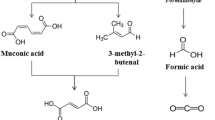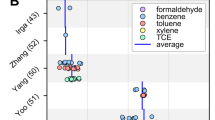Abstract
Indoor air-borne loads of volatile organic compounds (VOCs) are usually significantly higher than those outdoors, and chronic exposures can cause health problems. Our previous laboratory studies have shown that the potted-plant microcosm, induced by an initial dose, can eliminate high air-borne VOC concentrations, the primary removal agents being potting-mix microorganisms, selected and maintained in the plant/root-zone microcosm. Our office field-study, reported in the preceding paper, showed that, when total VOC (TVOC) loads in reference offices (0 plants) rose above about 100 ppb, levels were generally reduced by up to 75% (to < 100 ppb) in offices with any one of three planting regimes. The results indicate the induction of the VOC removal mechanism at TVOC levels above a threshold of about 100 ppb. The aims of this laboratory dose-response study were to explore and analyse this response. Over from 5 to 9 days, doses of 0.2, 1.0, 10 and 100 ppm toluene and m-xylene were applied and replenished, singly and as mixtures, to potted-plants of the same two species used in the office study. The results confirmed the induction of the VOC removal response at the lowest test dosage, i.e in the middle of the TVOC range found in the offices, and showed that, with subsequent dosage increments, further stepwise induction occurred, with rate increases of several orders of magnitude. At each dosage, with induction, VOC concentrations could be reduced to below GC detection limits (< 20 ppb) within 24 h. A synergistic interaction was found with the binary mixtures, toluene accelerating m-xylene removal, at least at lower dosages. The results of these two studies together demonstrate that the potted-plant microcosm can provide an effective, self-regulating, sustainable bioremediation or phytoremediation system for VOC pollution in indoor air.
Similar content being viewed by others
References
Alagappan, G. and Cowan, R.: 2003, ‘Substrate inhibition kinetics for toluene and benzene degrading pure cultures and a method for collection and analysis of respirometric data for strongly inhibited cultures’, Biotechnol. and Bioeng. 83(7), 798–809.
American Lung Association: 2001, ‘When you can't breathe, nothing else matters’, Air Quality, www.lungusa.org/air/.
Atwell, B., Kriedemann, P. and Turnbull, C. (eds): 1999, Plants in Action, Adaptation in Nature, Performance in Cultivation, Macmillan Education Australia Pty Ltd, Melbourne, Australia, pp. 85–103.
Bascom, R.: 1997, ‘Plenary Paper: Health and indoor air quality in schools’, In: J. E. Woods, D. T. Grimsrud and N. Boschi (eds), Proceedings of Healthy Buildings/IAQ'97 Global Issues and regional Solutions, Washington DC, Vol. 1, pp. 3–12.
Brasche, S., Bullinger, M., Gebhardt, H., Herzog, V., Hornung, P., Kruppa, B., Meyer, E., Morfield, M., Schwab, R. V., Mackensen, S., Winkens, A. and Bischof, W.: 1999, ‘Factors determining different symptom patterns of sick building syndrome — results from a multivariate analysis’, in Proceedings of Indoor Air ′99. The 8th International Conference on Indoor Air Quality and Climate, August, 1999, Edinburgh, Scotland, August, UK, 5, 402–407.
Brown, S. K.: 1997, ‘Volatile organic compounds in indoor air: sources and control’, Chemistry in Australia, January/February, 10–13.
Brown, S. K., Sim, M. R., Abramson, M. J. and Gray, C. N.: 1994,‘Concentrations of volatile organic compounds in indoor air — a review’, Indoor Air 4, 123–134.
Carpenter, D. O.: 1998, ‘Human health effects of environmental, pollutants: New insights’, Environmental Monitoring and Assessment 53, 245–258.
Carrer, P., Alcini, D., Cavallo, D., Visigalli, F., BollinI, D. and Maroni, M.: 1999, ‘Home and workplace complaints and symptoms in office workers and correlation with indoor air pollution’, in Proceedings of Indoor Air ′99. The 8th International Conference on Indoor Air Quality and Climate, August, 1999, Edinburgh, Scotland, UK, 1, 129–134.
Coward, M., Ross, D., Coward, S., Cayless, S. and Raw, G.: 1996, Pilot Study to Assess the Impact of Green Plants on NO2 Levels in Homes, Building Research Establishment Note N154/96, Watford, UK.
Environment Australia (EA): 2003, Technical Paper No. 6: BTEX Personal Exposure Monitoring in Four Australian Cities, Environment Australia, 2003. Canberra, ACT, Australia.
Giese, M., Bauer-Doranth, U., Langebartels, C. and Sandermann Jr. H.: 1994, ‘Detoxification of formaldehyde by the spider plant (Chlorophytum comosum L.) and by soybean (Glycine max L.) cell-suspension cultures’, Plant Physiol. 104, 1301–1309.
Godish, T. and Guindon, C.: 1989, ‘An assessment of botanical air purification as a formaldehyde mitigation measure under dynamic laboratory chamber conditions’, Environ. Pollut. 61, 13–20.
Greenberg, M. M.: 1997, ‘The central nervous system and exposure to toluene: A risk Characterization’, Environ. Res. 72, 1–7.
Hyatt, B. A., Oh, D. J.: 2002, University of Minnesota, Minnesota, USA. Biodegradation database. http://umbbd.ahc.umn.edu/mxy/mxy_map.html.
Lohr, V. I. and Pearson-Mims, C. H.: 1996, ‘Particulate matter accumulation on horizontal surfaces in interiors: Influence of foliage plants’, Atmos. Environ. 30, 2565–8.
Mólhave, L. and Krzyzanowski, M.: 2003, ‘The right to healthy indoor air: Status by 2002’, Indoor Air 13, Suppl. 6, 50–53.
Mosqueron, Nedellee, Kirchner et al.: 2003, ‘Ranking indoor air pollutants according to their health effects, for achieving priorities and costs optimisation in the French Permanent Survey of indoor air quality’, Proceedings Healthy Buildings 2003 7th International Conference 7–11 December 2003 National University of Singapore.
Merck Co., Inc.: 1989, The Merck Index, 11th ed., S. Budaveri, M. J. O'Neil, A. Smith, R. C.Heckelman, (eds), Merck Co. Inc. Rathway, N.J., USA, 1590.
MSDS (Materials Safety Data Sheets): 2005, database; www.ilpi.com.msds/
NOHSC (National Occupational Health and Safety Commission)(Australia): 1995, Exposure standards for atmospheric contaminants in the occupational environment: Guidance note on the interpretation of exposure standards for atmospheric contaminants in the occupational environment [NOHSC: 3008, (1995)] and ‘Adopted national exposure standards in the occupational environment’, [NOHSC: 1003, (1993)], Australian Government Publishing Service, Canberra, ACT, Australia.
Orwell, R., Wood, R., Tarran, J., Torpy, F. and Burchett, M.: 2004, ‘Removal of benzene by the indoor plant/substrate microcosm and implications for air quality’, Water, Soil and Air Pollut. 157, 193–207.
Paralesi, R. and Haddock, J. D.: 2004, ‘Microbial reactions play key roles in biocatalysis and biodegradation’, Current Opinion in Biotechnol. 15, 374–379.
Prah, J. D., Case, M. W., Goldtein, G. M.: 1998, ‘Equivalence of sensory responses to single and mixed volatile organic compounds at equimolar concentratations’, Environ. Health Perspectives 106(11), 1–8.
Pucci, O. H., Bak, M. A., Perressutti, S. R., Klein, I., Haertig, C., Alverez, H. M. and Wuensche, L: 2000, ‘Influence of crude oil contamination on the bacterial community of semiarid soils of Patagonia (Argentina)’, Acta Biotechnol. 20(2), 129–146.
Rehwagen, M., Schlink, U. and Herbarth, O.: 2003, ‘Seasonal cycle of VOCs in apartments’, Indoor Air 13 (3), 283–291.
Sharma, A., Sahgal, M. and Johri, B. N.: 2003, ‘Microbial communication in the rhizosphere: Operation of quorum sensing’, Current Science (Bangalore), 85 (6), 1164–1172.
Siciliano, S. D., Germida, J. J., Banks, K. and Greer, C. W.: 2003, ‘Changes in microbial community composition and function during a polyaromatic hydrocarbon phytoremediation field trial’, App. Environ. Microbiol. 69(1), 483–489.
Sullivan Jr., J. B., Van Ert, M. D., Krieger, G. R. and Brooks, B. O.: 2001, ‘Indoor environmental quality and health’, in (2nd Ed) J. B. Sullivan Jr. and G. R. Krieger, (eds), Clinical Environmental Health and Toxic Exposures Lippincott Williams & Wilkins, a Walter Kluwer Co., Philadelphia, PA, USA, 669–704.
Tarran, J., Orwell, R., Burchett, M., Wood, R. and Torpy, F.: 2002, Quantification of the Capacity of Indoor Plants to Remove Volatile Organic Compounds under Flow-through Conditions, Final Report on Horticulture Australia Ltd, Sydney, Australia.
Wolkoff, P.: 2003, ‘Trends in Europe to reduce the indoor air pollution of VOCs’, Indoor Air 13, (Suppl. 6), 5–11.
Wolverton, B. C.: 1985, ‘Volatile organic compounds — Sources, measurements, emissions and the impact on air quality’, Indoor Air Suppl. 3.
Wolverton, B. C., Johnson, A. and Bounds, K.: 1989, Interior Landscape Plants for Indoor Aire, Final Report, Sept., NASA Stennis Space Centre MS.
Wolverton, B. C. and Wolverton, J. D.: 1993, ‘Plants and soil microorganisms: removal of formaldehyde, xylene, and ammonia from the indoor environment’, J. Mississippi Acad. Sci. 38(2), 11–15.
World Health Organisation (WHO), 1999, Guidelines for Air Quality, WHO, Geneva.
World Health Organisation (WHO): 2000, The Right to Healthy Indoor Air — Report on a WHO Meeting, Bilthoven, The Netherlands. European HEALTH Targets 10, 13.
Wood, R., Orwell, R., Burchett, M., Tarran, J. and Brown, S.: 2000, ‘Absorption of organic compounds in indoor air by commonly used indoor plants’, in O. Seppanen and J. Sateri (eds), Proceedings of Healthy Buildings 2000, 6th Healthy Buildings International Conference, August, 2000, Espoo, Finland, Vol. 2, 125–30.
Wood, R., Orwell, R., Tarran, J., Torpy, F., and Burchett, M.: 2002, ‘Potted plant growth media: Interactions and capacities in removal of volatiles from indoor air’, J. Environ. Hort. Biotechnol. 77(1), 120–129.
Wrenn, B.A.: 1998, ‘Biodegradation of aromatic hydrocarbon's, University of Maryland, ML, USA. http://www.glue.umd.edu/∼eseagren/bioAHC97.htm.
Yeom, S. H., Yoo, Y. J. and lee, J. W.: 1997, ‘The importance of microbial adaptation in the degradation of BTEX’, Global Environmental Technology, D.I. Wise, (ed.), Elsevier Science B.V. 665–675.
Zeng, Y.: 2004, University of Minnesota, Minnesota, USA. Biodegradation database, http://umbbd.ahc.umn.edu/tol/tol_map.html
Author information
Authors and Affiliations
Corresponding author
Rights and permissions
About this article
Cite this article
Orwell, R.L., Wood, R.A., Burchett, M.D. et al. The Potted-Plant Microcosm Substantially Reduces Indoor Air VOC Pollution: II. Laboratory Study. Water Air Soil Pollut 177, 59–80 (2006). https://doi.org/10.1007/s11270-006-9092-3
Received:
Accepted:
Published:
Issue Date:
DOI: https://doi.org/10.1007/s11270-006-9092-3




